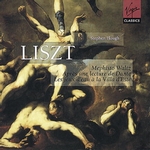독주곡 | 메피스토 왈츠 01번 S.514 - 피아노: 스티븐 허프 (1987)
페이지 정보
작성자 이상한나라 작성일16-03-04 17:07본문

Liszt - Mephisto Waltz No.1 S.514
스티븐 허프 (피아노)
Stephen Hough (piano)
1987/08 (ⓟ 1988) Stereo (DDD)
Henry Wood Hall, London
메피스토 왈츠》는 헝가리의 작곡가 프란츠 리스트가 괴테의 파우스트를 읽고 영감을 얻어서 1883년에 쓴 피아노 작품이다.
총 네 곡으로 구성되어 있으며 각각은 3/4박자이다. 제1번 ‘마을 술집에서의 춤’은 메피스토 왈츠 중에서 가장 잘 알려진 곡이다.

Excerpt from the beginning of the Mephisto Waltz No. 1.
Mephisto Waltz No. 1 is the most well-known and musically successful of the series. The others pale in comparison, to rank as "obscure repertoire".
Mephisto Waltz No. 1, Der Tanz in der Dorfschenke (The Dance in the Village Inn) is the second of two short works he wrote for orchestra. While the work preceding it, Midnight Procession ("Der nächtliche Zug"), is rarely given (though both works have been recorded together). The waltz, however, had been a concert favorite, with its passion, sensuality and dramatics generating an emotional impact. James Gibbons Huneker described the work's "langourous syncopated melody" as "one of the most voluptuous episodes outside of the Tristan score."
Liszt intended to publish the Waltz simultaneously with the Night Procession: "...The publication of the two Lenau's Faust episodes... I entrust to Schuberth's own judgement; as to whether the piano version or the score appears first, makes no difference to me; the only important thing is that both pieces should appear simultaneously, the Night Procession as No.1 and the Mephisto Waltz as No.2. There is naturally no thematic relationship between the two pieces; but they are related nonetheless by all the contrasts of emotions. A Mephisto of this kind may only arise from such a poodle!..." Liszt’s request was not fulfilled and the two episodes were published separately.
The waltz was conceived as both an orchestra and a piano work. Three versions, orchestral (S.110/2), piano duet (S.599/2) and piano solo, (S.514), all date more or less from the same period (1859-62). The piano duet version is a straightforward transcription of the orchestral version, while the solo piano version is an independent composition. Liszt dedicated the piece to Carl Tausig, his favourite pupil (who died prematurely at the age of 29 in 1870).
The orchestral version also has an alternate, softer ending which, while not as rousing as the usual coda, some critics argue is closer to the intent of Lenau's tale. While this ending is not often heard in the concert hall, both Fritz Reiner and James Conlon have recorded it. He also provided two extra passages for the piano solo version. It is not known when Liszt wrote these extra passages, but it was a habit of his later years to make alterations while teaching his works to his pupils.
While many pianists use this intense, masterful, and technically formidable work simply to display technical skills, particularly speed, (despite consequent note-omissions, note-bluffing, and/or handfuls of mishaps, let alone musical incomprehensibility), the initial tempo is marked "allegro vivace (quasi presto)". While the terms presto and quasi presto may be found at various points, the term prestissimo is never used. The title, "Waltz" should be borne in mind. At too rapid a tempo, not only is the spirit of the waltz form sacrificed, but the more subtle aspects of the music may well be drowned by such anxious rushing. The opening time signature is 3/8 (not 2/2 in semiquaver triplets). The tempo caution is particularly true of the "espressivo amoroso" (Ricordi edition) section, in which Mephistopheles attempts to seduce the listener with his seeming sensitivity, empathy, gentility and charm...the same sort of "heart-tugging" as found in the same composer's Liebestraume and Consolations. A wise guide to tempo is found in the original orchestral version (as heard in the movie, "The Mephisto Waltz").
A truly ingenious composition, this work is a wonderful example of Liszt's compositional method of thematic metamorphosis, and to his harmonic and pianistic inventiveness.
리스트 메피스토 왈츠 1번 Mephisto Waltz No.1 S.514 [10:51]
댓글목록
등록된 댓글이 없습니다.



